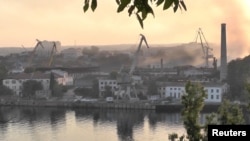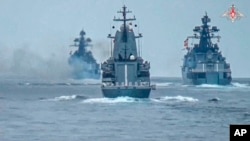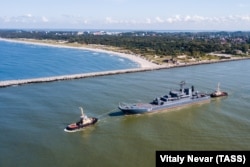Five years ago, a massive floating dry dock near the Russian Arctic port of Murmansk accidentally sank and nearly took the flagship of the Russian Navy, the aircraft carrier Admiral Kuznetsov, with it.
It was a major headache for Russia's Navy: The dry dock, called the FD-50, was one of the only ones capable of servicing massive ships like the Kuznetsov or the battlecruiser Pyotr Veliky. The next closest was nearly 10,000 kilometers east in the Pacific region of Primorye.
Despite plans to raise it, the dock remains at the bottom of the Barents Sea harbor.
Now Russia has another dry dock problem in the home port of the Black Sea Fleet: Sevastopol, the naval port on the occupied-Crimean Peninsula.
Two adjacent docks at the Sevmorzavod repair facility were hit, reportedly with British-supplied cruise missiles, on September 13, damaging at least two ships under repairs, including a submarine.
It's unclear whether the attack -- the largest on the Russian fleet base since Russia launched its full-scale invasion in February 2022 -- damaged only the two ships or the dry docks themselves.
Either way, experts say, Black Sea naval capabilities are likely seriously curtailed for the foreseeable future. There are no comparable facilities capable of conducting major repair works on Russian naval ships anywhere else in the Black Sea.
"While the specific strike will have an impact on [Black Sea Fleet] operations, the larger impact is cumulative," said Dmitry Gorenburg, a research scientist who focuses on the Russian military at the Center for Naval Analyses, a think-tank near Washington, D.C. "Overall, I see Russia's control over the Black Sea slipping gradually."
Thord Are Iversen, a Norwegian defense analyst and former Royal Norwegian Navy officer, said the docks themselves seem to have to only sustained superficial damage.
"Dry docks are hard targets, difficult to inflict heavy damage to. The main challenge will likely be to clear the wreckage," he said.
'Now A Barn Rather Than A Factory'
Since seizing and occupying Crimea in 2014, Russia has expanded its military footprint on the peninsula, building up garrisons and air defenses. It's invested heavily in infrastructure in Sevastopol, a historic naval port that previously housed both the Russian and Ukrainian Black Sea navies.
With its annexation, Russia seized the few remaining ships belonging to the Ukrainian Navy that were housed at Sevastopol. Other Ukrainian ships were either scuttled, sunk, or seized elsewhere around the Black Sea and the Sea of Azov.
With its dominance of the Black Sea, Russia used its navy to transfer personnel and equipment to Crimea and elsewhere. More significantly, it used ships to bombard Ukrainian cities and military forces with cruise missiles.
On April 14, 2022, the flagship of Russia's Black Sea Fleet, the guided missile cruiser Moskva, was hit and sunk west of Crimea, south of the port of Odesa. Ukrainian officials later said modified Neptune anti-ship missiles had been used in the attack, a major embarrassment for the Russian Navy.
Estimates of the death toll among sailors ranged from a couple dozen to hundreds; a week after the incident, Russia's Defense Ministry said one sailor had died and 27 were missing, figures that many experts concluded were implausible.
Russian surface ships and submarines have continued to play a role in the ongoing war, mainly firing missiles at land targets but also shadowing Ukrainian cargo ships used to ship grain to world markets.
At the same time, with the help of billions of dollars in Western weaponry and equipment, Ukraine's armed forces have gradually built up their arsenals including artillery and rocket systems, kamikaze drones that function like mini-missiles, and longer-range missiles.
That includes air-launched cruise missiles from Britain -- called Storm Shadows -- and a French variant called SCALP.
In the early morning of September 13, Ukraine targeted the Sevastopol port facilities, including the Sevmorzavod repair facility, with a barrage of 10 cruise missiles. At least 24 people were wounded in the Sevastopol attack, according to local Russian administrators.
The Russian Defense Ministry claimed its air-defense systems downed seven missiles. It also said three unmanned maritime drones had attacked the patrol ship Vasily Bykov off of Crimea but the ship had destroyed the drones.
Andriy Yusov, a spokesman for Ukraine's military intelligence agency, said two ships on two adjacent dry docks at Sevmorzavod -- a landing ship called the Minsk and a Kilo-class diesel submarine called the Rostov-on-Don -- had been destroyed.
The claims could not be independently verified.
However, satellite imagery released over the following days showed the two damaged ships. Naval experts said the Minsk appeared to have been heavily damaged, possibly rendered inoperable. The Rostov-On-Don, one of four cruise-missile capable submarines in the Black Sea Fleet, also sustained major damage.
The Russian Defense Ministry, meanwhile, said the ships will be fully restored and "will continue to serve in combat as part of their fleets."
Experts said the evidence was less clear about whether the dry docks were damaged. But it will take considerable time to remove the damaged ships -- possibly months. The bigger question now is whether other Russian ships, specifically submarines, can be serviced and repaired.
The Russians "have nowhere to repair damaged ships," Natalya Humenyuk, a spokesman for Ukraine's southern military command, said in post on Telegram, because the repair facility now resembles "a barn rather than a factory."
"Long term, depending on how long it takes to get the docks attacked back in operation, the impact on maintenance could prove significant," Iversen told RFE/RL. "Delays in maintenance could consign ship and subs to port, making them unavailable for operations and vulnerable to Ukrainian attacks."
There are a limited number of other floating docks in Crimea, as well as in other Crimean ports like Kerch and Feodosiya. But experts said those all lack the specialized infrastructure needed to do complicated repairs, on submarines or many naval ships.
In Novorossiysk, for example, a major oil and gas port located about 500 kilometers east of Sevastopol, there are no facilities for servicing specific naval ships like submarines.
"Future Ukrainian strikes could add to the maintenance problems. If they inflict damage to key facilities in Sevastopol it could turn critical, and the Russians have no easy ways out of this situation," Iversen said. "Retrofitting another yard to take over from Sevastopol will take time -- time a Black Sea Fleet at war does not have."
Ukraine's military intelligence agency on September 11 announced that its forces had recaptured several offshore oil and gas drilling platforms known informally as Boyko Towers. Russian forces have used the strategically located platforms as forward bases and helicopter pads; Russia was also believed to have installed radar installations and missile systems on the platforms.
The willingness of Ukraine to use air-launched cruise missiles to target Russian facilities and air defenses in Crimea, plus seizing the oil-and-gas platforms, highlights "a steady deterioration" of the Russian Black fleet's ability to protect itself, Gorenburg said.
"Russian ships are increasingly vulnerable in port in Sevastopol," he told RFE/RL. "Repairs are difficult when your dry docks can be attacked."
Either way, Ukraine expects to be able to conduct more attacks on Russian ships, Digital Transformation Minister Mykhaylo Fedorov said on September 15.
"There will be more drones, more attacks, and fewer Russian ships. That's for sure," he told Reuters.
















